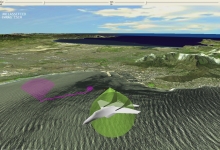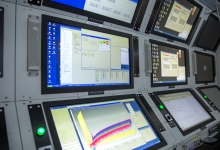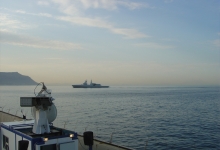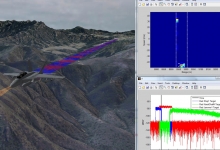Digital electronic warfare
The Digital electronic warfare research group focuses on research and development of electronic warfare products and services. These include:
- The radio frequency electronic warfare defence evaluation research institute;
- Sensors and electronic warfare engagement simulation;
- Passive radar;
- Next-generation adaptive jammer using phased array;
- Dynamic scenario planner;
- Electronic warfare mission support system;
- Electronic warfare 101 e-Learning tool;
- Cognitive electronic warfare; and
- Cyber electromagnetic battle management.
Projects:
Radio Frequency Electronic Warfare Defence Evaluation Research Institute
The CSIR undertakes directed multidisciplinary research and technological innovation that uses scientific or specialised techniques to generate approaches to defence problem-solving and decision-making for the South African National Defence Force (SANDF) in cooperation with partners in government, industry and academia.
Electronic warfare is used to determine, exploit, reduce or prevent hostile use of the electromagnetic spectrum, while retaining its friendly use. To maintain electromagnetic spectrum dominance requires effective research and technology development, testing, evaluation, modelling, simulation and integration. This focus supports the SANDF in being a smart user, smart buyer and smart decision-maker.
Sensors and Electronic Warfare Engagement Simulation
The Sensors and Electronic Warfare Engagement Simulation (SEWES) is a few-on-few electronic warfare simulation environment. Any number of platforms consisting of any number of sensors and electronic warfare systems can engage each other in a simulated environment. SEWES is used by defence research institutes for electronic warfare effectiveness evaluation, doctrine development, and training.
The SEWES architecture and models are built on MATLAB and Simulink as the primary environment. Platforms, sensors, weapons and countermeasures are modelled in Simulink, and an extensive model library is available. A powerful scalable and distributed simulation is realised using a combination of innovative features. SEWES is one of the most advanced electronic warfare simulators in the world.
Passive radar
Passive radar is a class of radar that makes use of third-party illuminators. For example, public broadcasting services such as frequency modulation radio, to illuminate an aircraft(s) of interest and subsequently locate and track these aircrafts by processing the signals reflected from the aircraft. Given the absence of a dedicated transmitter subsystem in passive radar systems, it serves as a cost-effective radar solution that requires no spectrum licensing, consumes significantly less power, requires minimal equipment and has reduced maintenance costs.
The CSIR has undertaken research and development (R&D) to develop a national multistatic passive radar facility that was developed to technology demonstrator maturity. The current facility comprises five nodes in the Gauteng area, gathering data for long-term passive radar performance characterisation. The CSIR has been developing a deep science, engineering and technology expertise in the field for over a decade.
Next-generation adaptive jammer using phased array
The CSIR and an international partner are developing an advanced surface-based radar jammer based on active electronically scanned array technology and the latest processing technologies, including digital radio frequency memory and heterogeneous computing for multithreat engagement. The system is envisioned to be based on VPX standards that can operate in a spectrum of conflict, which could vary from surveillance to insurgents in a civilian-commercial setting to high-intensity state-on-state conflict.
Dynamic scenario planner
The dynamic scenario planner (DSP) is a generic lightweight software application for the setup, planning and visualisation of sensor and electronic warfare engagements. It is the generic and scalable front-end for scenario data input and analysis by sensor and electronic warfare system developers. Using standardised interface definitions, the DSP can be integrated into a hardware or software system and paired with a compiled simulation engine.
Electronic Warfare Mission Support System
The Electronic Warfare Mission Support System (EWMSS) is a software-based product that provides pre-mission planning, in-mission support and post-mission debriefing for military training, testing and evaluation of missions to enhance mission and training effectiveness. The EWMSS is targeted to address needs in adversary air combat training and electronic warfare range.
The EWMSS is a joint technology development project between the CSIR and Midnite Aerospace Solutions (MAS), an industry partner based on complementary skill sets. The CSIR has developed a strong capability in electronic warfare modelling and simulation-based software and MAS has a strong capability in mission engineering.
Electronic warfare 101 E-learning tool
The CSIR has developed an e-learning tool to introduce people with no prior exposure to the field of electronic warfare. The tool was developed to broaden the electronic warfare knowledge of military personnel and is deployed in the SANDF and the SANDF Military Academy.
The tool was developed on software called Articulate Storyline 2, which allows for simple user development for an interactive course. The tool can be deployed as a standalone or onto a learner management system, with interaction between learner and course coordinator.
Cognitive electronic warfare
Cognitive electronic warfare is an emerging area of R&D for the CSIR team. The increase in density and complexity of the electromagnetic domain, and the adaptive and evolving nature of threats far outpace electronic warfare operators' ability to cope with the workloads associated with traditional electronic warfare technologies.
To sense and analyse the increasingly vast range of eletromagnetic signals, increased automation, as well as the ability to learn and adapt are required. The use of artificial intelligence and machine learning algorithms and techniques to realise electronic warfare systems that have this ability to learn and adapt to a changing electronic warfare environment is often termed cognitive electronic warfare.
Cyber electromagnetic battle management
Electromagnetic battle management is an emerging area of R&D for the team. The eletromagnetic spectrum is the singular unifying physical entity across nations, services and agencies. Anything that operates in the eletro magnetic spectrum (communicates, senses, conceals or attacks) must be coherently managed, and the only way to execute each of these responsibilities well, is to plan to do them all together. This leads to the concept of electromagnetic battle management.
It provides an electromagnetic spectrum situational awareness tool for joint electromagnetic spectrum operations across the various echelons of military command. It includes forward-looking situational awareness to enable manoeuvre and rapid decision-making and deny an adversary the use of the electromagnetic spectrum.
The convergence of electronic warfare and cyber capabilities also presents opportunities – cell phones and digital radios use spectrum to communicate, while they perform digital applications in the cyber domain. The overlap of electronic warfare and cyber is very important; hence the extended concept of cyber electromagnetic battle management.






